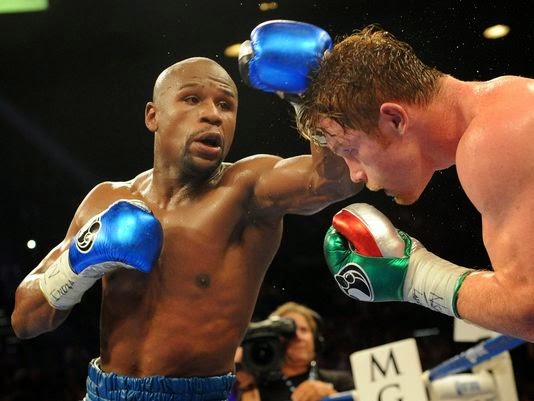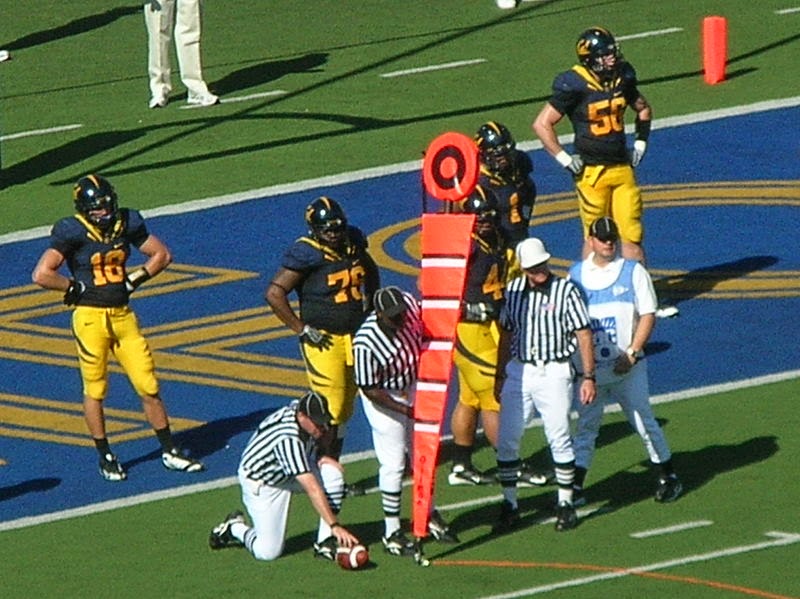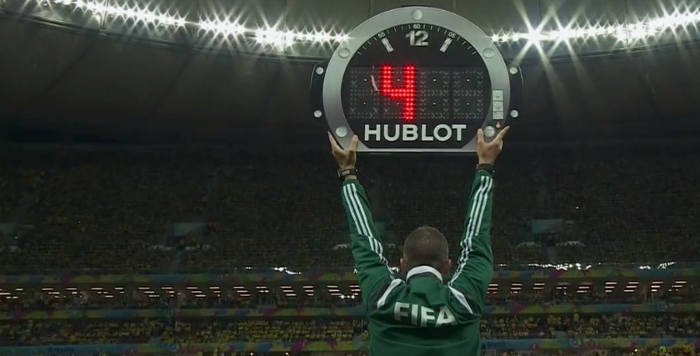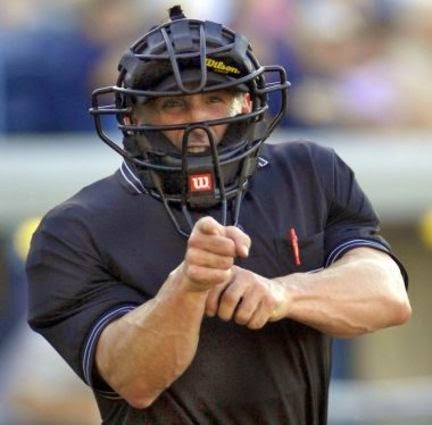Sports are the ultimate meritocracy. Color and creed do not matter. Whoever runs the fastest, throws the farthest and performs in the clutch can win glory in the world of sports. The underdog always has a chance. David can beat Goliath if his aim is true. And yet, some aspects of sports are incredibly arbitrary.
I'm not talking about luck here. This list is not about bad hops at third base, golf balls landing in divots or gusts of wind pushing field goals wide of the uprights. This list is restricted to situations where the very rules themselves create arbitrary and capricious results.
First Downs in Football. As far as I'm concerned, football is the most perfect sport ever invented. However, one of the most arbitrary things in all of sports is the method for determining first downs. Boiled down to its simplest elements, here is what happens:
At the start of a series, the head linesman spots the football. Then the chain gang on the sidelines eyeballs things from about twenty-five yards away and places one end of the chains at the spot of the ball. Then when a player gets tackled near a ten-yard gain, the head linesman trots in, retrieves the football from wherever the ball carrier dropped it and places the football at the spot where he believes the ball carrier's forward momentum stopped. Keep in mind, this is all done after the players have untangled themselves from the play.
Then comes the moment of truth. The haphazardly placed chains are brought out onto the field and stretched out. Despite all the random and arbitrary decisions made to this point, the referees and the fans squint to see if a cigarette paper can be slid between the first down marker and the nose of the football. In the most popular sport in the world's most powerful nation, this is how we determine whether the offense gets another set of downs or whether it is time for a punt.
Scoring in Boxing. Banshee Sports looks askance at any sport that is judged, but since boxers have the ability to take things into their own hand by actually concussing an opponent into unconsciousness, I do consider boxing a legitimate sport worthy of attention. Nonetheless, many fights do come down to the judges' scorecards.
In professional boxing, each round is judged on a "10-point must" system. That means that the winner of the round is given ten points. Theoretically, the judges can declare a round a draw and give both fighters the full ten points for the round. Although the judges also have the authority to award the losing boxer in a round any number of points they believe is appropriate, typically, as long as a boxer stays on his feet, he will get nine points. A boxer gets eight points if they are knocked down once and seven points if they are knocked down twice.
 |
| (Jayne Kamin-Oncea/USA Today) |
Many rounds in many fights are very close. Sitting at ringside, it is very difficult for a judge on the wrong side of the ring to know if a flurry of punches connected or was blocked or partially parried. Yet, that judge who could not see has to award ten points to one of the fighters. A judge will award a fighter ten points even if they only won by a hair's breadth based on a bad vantage point. If the boxer that lost by a narrow margin in the first round dominates the second round by fails no knock down is scored, the judge's score card at the end of two rounds will show a 19-19 tally.
The sports world talks a lot about corruption in boxing and the bias of judges, but perhaps the bizarre decisions really have more to do with the arbitrary nature of the "10-point must" system and the vantage points of the ringside judges.
Stoppage Time in Soccer. World Cup fever swept through our nation this summer. For many of us, this was the first time we were exposed to "stoppage time." For American sports fans who are used to replay review of all the mininutia in all major sports, this phenomenon was a bit of mystery.
Each half in soccer consists of forty-five minutes. No matter what happens, the clock continues to run. At the end of each half, the referee extends the play for an amount of time determined solely by that referee. That extra time is then announced to the teams, fans and TV audience. It is announced to the nearest minute. Not the nearest second. And certainly not the nearest tenth of a second, as American sports fans are accustomed.
Theoretically, the extra time equals the amount of time wasted for injuries and substitutions. In reality, the stoppage time awarded is some amount time that is far less than the actual time used up tending to the apparently grievously wounded players who did not even draw a yellow card. Then, regardless of the time that is posted in the stadium, the half or game ends whenever the referee decides to blow the final whistle, and none of the players or the coaches know precisely when the whistle may blow.
In a sport where games are decided on a single goal scored in a split second, everyone is expected to have faith that the referee made a good decision as to the amount of stoppage time and when that time actually expires. If this is not arbitrary, I do not know what is.
NASCAR. Pretty much all of it. For the other sports, I focused in on a particular rule, but with NASCAR, it's simply too hard to narrow down. Now, don't get me wrong. I love NASCAR. I am looking at a wall full of die cast cars while I type this, but the decisions and rules in this sport are the very definition of arbitrary and capricious.

Say something off-color in a post race interview? You might get docked championship points. Just ask Dale Junior in 2004. Intentionally manipulate the finishing order in a race to help your teammates get into the Chase? NASCAR will come up with some sort of penalty on the fly that restores what they believe to be the status quo. Just ask everyone involved in the fall race at Richmond in 2013. Then there is the weather issue. The decision about when to start a race when rain is in the forecast is a mystery to everyone. Likewise, the decision-making process about when to call off a race after the halfway point and when to wait out a lengthy rain delay is more mysterious than the Shroud of Turin.
I have now written about 100 words about the arbitrary decisions of NASCAR and I didn't even addressed the year-to-year changes in how the champion will be crowned or the mid-season changes to the aero packages.
Unlike the other major American sports, NASCAR is controlled by one family. The rules change when the France family says they do. That does not keep me from watching every race, but it does require me to put NASCAR as an entire sport on this list.
Balls and Strikes. All the world over, a baseball diamond has the same dimensions. There are ninety feet between bases. There are sixty feet and six inches from the pitcher's rubber to home plate. And yet, the one thing that impacts the game more than anything else changes from game to game and pitch to pitch. That one thing is the strike zone.
The rule book has a definition for the strike zone, but in reality, it is defined on a game-by-game basis by the home plate umpire. I understand that umpires are human, so I am not griping about an occasional missed call on balls and strikes. My point here is that the umpire actually gets to redefine the strike zone every game.
Baseball fans have grown accustomed to hearing announcers say, "Phil Cuzzi is behind the dish, so you can expect a generous strike zone tonight." If you put that phrase in other sports, the absurdity becomes clear. Imagine tuning into the finals at Wimbledon and seeing that there are no lines on the grass at the All England Club and hearing Patrick McEnroe state, "With Cuzzi in the chair, we can expect wide lines today. Federer will really have to run." When you think about it like that, the arbitrary nature of balls and stokes seems positively outrageous.
I will always love sports and cling to their results as confirmation that excellence is rewarded in the world. However, the examples listed above show that even in the ultimate meritocracy there is an element of human capriciousness.
Subscribe to Banshee Sports by Email
 Big Ron's Rum Punch
Big Ron's Rum Punch













